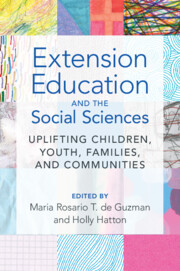Book contents
- Extension Education and the Social Sciences
- Extension Education and the Social Sciences
- Copyright page
- Contents
- Contributors
- Part I Overview of Extension and the Social Sciences
- Part II Addressing Key Issues in the Well-Being of Children, Youth, and Families
- Part III Looking Ahead: Emerging Issues and Trends
- Chapter 10 Cooperative Extension and Diversity
- Chapter 11 Reaching and Serving Underrepresented Families
- Chapter 12 Preparing the Next Generation of Extension Professionals
- Chapter 13 Extending Extension’s Outreach and Engagement with Social Media
- Index
- References
Chapter 10 - Cooperative Extension and Diversity
Supporting Children, Youth, and Families amid Demographic and Social Change
from Part III - Looking Ahead: Emerging Issues and Trends
Published online by Cambridge University Press: 28 March 2024
- Extension Education and the Social Sciences
- Extension Education and the Social Sciences
- Copyright page
- Contents
- Contributors
- Part I Overview of Extension and the Social Sciences
- Part II Addressing Key Issues in the Well-Being of Children, Youth, and Families
- Part III Looking Ahead: Emerging Issues and Trends
- Chapter 10 Cooperative Extension and Diversity
- Chapter 11 Reaching and Serving Underrepresented Families
- Chapter 12 Preparing the Next Generation of Extension Professionals
- Chapter 13 Extending Extension’s Outreach and Engagement with Social Media
- Index
- References
Summary
The Cooperative Extension System plays a critical role in the tripartite mission of the land-grant university system – serving as a means of disseminating research findings generated in universities and research centers for the direct benefit of people of the community in which it is embedded. Rooted in agricultural education and initially focused on supporting well-being among residents of rural communities, Extension has evolved to address the needs among the country’s changing demographic. In this chapter, we will provide an overview of demographic changes that have had important implications for Extension programming; describe examples of federal, state, and regional initiatives that address new challenges and meet the needs of a rapidly diversifying audience base; as well as highlight current gaps and areas that need further attention. We end the chapter by proposing future directions in Extension programming to better address the needs of diverse populations.
Keywords
- Type
- Chapter
- Information
- Extension Education and the Social SciencesUplifting Children, Youth, Families, and Communities, pp. 205 - 223Publisher: Cambridge University PressPrint publication year: 2024



